|
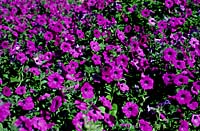 'LAURA
BUSH' PETUNIA is a reseeding annual, old-fashioned petunia. It
is more cold tolerant, disease resistant and heat tolerant than
most modern hybrids. The plant has a spreading growth habit with
deep violet, medium size flowers. 'Laura Bush' Petunia is the
offspring of the 'V.I.P.' petunia (Very Important Petunia or Petunia
violacea (Violet In Profusion) This 'V.I.P.' petunia is native
to South America. The 'V.I.P.' flower is violet colored and the
plant is heat tolerant and low spreading. The 'V.I.P.' plant is
known for its profusion of small bell-shaped violet colored flowers.
Both dainty and durable, it's one of the parents of all modern
petunias. It is a great plant for beds, baskets or barrels. The
'V.I.P.' offspring, 'Laura Bush' petunia, offers just as many
colorful blooms but the blooms are twice as large and the plant
has larger, darker green foliage which serves as a background
to showcase the spectacular floral display. 'LAURA
BUSH' PETUNIA is a reseeding annual, old-fashioned petunia. It
is more cold tolerant, disease resistant and heat tolerant than
most modern hybrids. The plant has a spreading growth habit with
deep violet, medium size flowers. 'Laura Bush' Petunia is the
offspring of the 'V.I.P.' petunia (Very Important Petunia or Petunia
violacea (Violet In Profusion) This 'V.I.P.' petunia is native
to South America. The 'V.I.P.' flower is violet colored and the
plant is heat tolerant and low spreading. The 'V.I.P.' plant is
known for its profusion of small bell-shaped violet colored flowers.
Both dainty and durable, it's one of the parents of all modern
petunias. It is a great plant for beds, baskets or barrels. The
'V.I.P.' offspring, 'Laura Bush' petunia, offers just as many
colorful blooms but the blooms are twice as large and the plant
has larger, darker green foliage which serves as a background
to showcase the spectacular floral display.
People always want characteristics in plants
which are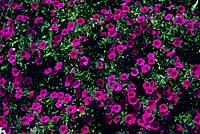 uncharacteristic of that plant type. For instance, we want citrus
trees which produce good tasting fruit and tolerate minus 20 degree
F. temperatures; we want tomatoes which will store for months
after harvesting, produced on cold tolerant plants; we want flowers
to grow in stone and bloom all year; we want petunias to tolerate
the hot temperatures of summer and the cold temperatures of winter
yet have a multitude of blooms. Why can't these characteristics
be incorporated into the plant of our choice? For such wondrous
characteristics to be utilized in a plant variety, the desired
traits must be genetically inherent in some plant line(s) of that
particular species so that, via plant breeding, these traits can
be transferred to the ultimate, hybridized super-plant. Many times
we want too much, i.e., you can't make a silk purse out of a sow's
ear. But in the case of petunias, especially in the case of creating
a petunia which tolerates the hot summer temperatures and the
cold temperatures of most Texas' winters yet has a multitude of
blooms, the Mother ('V.I.P.') of all petunias which fulfills the
heat and bloom requirements has been brought from Germany by Greg
Grant, former Extension horticulturist, Director of product development
for Color Spot Growers, and lecturer at Stephen F. Austin University.
This tough little V.I.P. petunia was observed at a horticulture
exposition in Stuttgart, Germany in July, 1993.
uncharacteristic of that plant type. For instance, we want citrus
trees which produce good tasting fruit and tolerate minus 20 degree
F. temperatures; we want tomatoes which will store for months
after harvesting, produced on cold tolerant plants; we want flowers
to grow in stone and bloom all year; we want petunias to tolerate
the hot temperatures of summer and the cold temperatures of winter
yet have a multitude of blooms. Why can't these characteristics
be incorporated into the plant of our choice? For such wondrous
characteristics to be utilized in a plant variety, the desired
traits must be genetically inherent in some plant line(s) of that
particular species so that, via plant breeding, these traits can
be transferred to the ultimate, hybridized super-plant. Many times
we want too much, i.e., you can't make a silk purse out of a sow's
ear. But in the case of petunias, especially in the case of creating
a petunia which tolerates the hot summer temperatures and the
cold temperatures of most Texas' winters yet has a multitude of
blooms, the Mother ('V.I.P.') of all petunias which fulfills the
heat and bloom requirements has been brought from Germany by Greg
Grant, former Extension horticulturist, Director of product development
for Color Spot Growers, and lecturer at Stephen F. Austin University.
This tough little V.I.P. petunia was observed at a horticulture
exposition in Stuttgart, Germany in July, 1993.
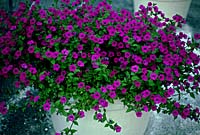 There
are basically five types of petunias: the double Grandiflora,
double Multiflora, single Grandiflora which includes the large
flowering cascades, single Multiflora, and California giants.
The size of the flowers vary anywhere from the smallest of one
inch in diameter to five to six inches. In the case of petunias,
big IS NOT best! The big blooms of the Grandiflora petunias are
showy and look nice in catalogs but they are not durable or practical.
The lightest rain or watering will droop and discolor the large
Grandiflora blooms. Since the bloom is the focal point of a flower
bed, the gardener wants as many beautiful blooms as possible. There
are basically five types of petunias: the double Grandiflora,
double Multiflora, single Grandiflora which includes the large
flowering cascades, single Multiflora, and California giants.
The size of the flowers vary anywhere from the smallest of one
inch in diameter to five to six inches. In the case of petunias,
big IS NOT best! The big blooms of the Grandiflora petunias are
showy and look nice in catalogs but they are not durable or practical.
The lightest rain or watering will droop and discolor the large
Grandiflora blooms. Since the bloom is the focal point of a flower
bed, the gardener wants as many beautiful blooms as possible.
Multiflora petunias such as the Carpet series
have been the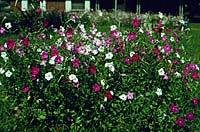 champs -- small, but durable and prolific. Multiflora petunias
have medium-sized blooms and lots of them. Multiflora types are
more disease tolerant and withstand South Central Texas winters
better than other bloom types mentioned. Because 'Laura Bush'
is a Multiflora petunia type, it inherits these characteristics
which make it durable and beautiful. 'Laura Bush' petunia is the
offspring of a chance cross of a single clone of 'V.I.P.' selected
from a few seed from Germany and a mixed strain of old-fashion
petunia in 1994. The 'V.I.P.' was the female parent and old-fashioned
petunia was the male or pollen parent. The seedlings were planted
at the San Antonio Botanical Center and on a hot day in June,
1996, 20 selections were made by Greg Grant and propagated by
cuttings at Peterson Brothers Nursery. The rooted cuttings were
transplanted into a field at the Henry Verstuyft farm in July,
1996, by Bexar County Master Gardeners. The heat of July eliminated
over one-half of the selections but some selections were not at
all affected by the hot summer temperature. The cold weather (22
degrees F.) of January, 1997, killed the rest -- except for the
selection eventually named 'Laura Bush' by Greg Grant at Stephen
F. Austin University in April, 1998. It is the most prolific reseeding
hybrid petunia ever grown. The development of this petunia was
made possible by seed extraction and cleaning technology developed
by John Thomas of Wildseed Farms in Fredericksburg, Texas. Wildseed
Farms is the exclusive distributor of 'Laura Bush' petunia seed.
Selections have been made which are violet, pink and purple.
champs -- small, but durable and prolific. Multiflora petunias
have medium-sized blooms and lots of them. Multiflora types are
more disease tolerant and withstand South Central Texas winters
better than other bloom types mentioned. Because 'Laura Bush'
is a Multiflora petunia type, it inherits these characteristics
which make it durable and beautiful. 'Laura Bush' petunia is the
offspring of a chance cross of a single clone of 'V.I.P.' selected
from a few seed from Germany and a mixed strain of old-fashion
petunia in 1994. The 'V.I.P.' was the female parent and old-fashioned
petunia was the male or pollen parent. The seedlings were planted
at the San Antonio Botanical Center and on a hot day in June,
1996, 20 selections were made by Greg Grant and propagated by
cuttings at Peterson Brothers Nursery. The rooted cuttings were
transplanted into a field at the Henry Verstuyft farm in July,
1996, by Bexar County Master Gardeners. The heat of July eliminated
over one-half of the selections but some selections were not at
all affected by the hot summer temperature. The cold weather (22
degrees F.) of January, 1997, killed the rest -- except for the
selection eventually named 'Laura Bush' by Greg Grant at Stephen
F. Austin University in April, 1998. It is the most prolific reseeding
hybrid petunia ever grown. The development of this petunia was
made possible by seed extraction and cleaning technology developed
by John Thomas of Wildseed Farms in Fredericksburg, Texas. Wildseed
Farms is the exclusive distributor of 'Laura Bush' petunia seed.
Selections have been made which are violet, pink and purple.
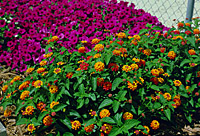 The
violet color, composed of purple and red pigments, practically
glows. According to color expert Ken Charbonnau, Director of Color
Marketing at Benjamin Moore Paint Company, the big news in color
are purple and blue-violet. In the backyard garden or for patio
containers, you may want to create a more relaxing and serene
mood by choosing cooler or softer colors which 'Laura Bush' petunia
provides. The
violet color, composed of purple and red pigments, practically
glows. According to color expert Ken Charbonnau, Director of Color
Marketing at Benjamin Moore Paint Company, the big news in color
are purple and blue-violet. In the backyard garden or for patio
containers, you may want to create a more relaxing and serene
mood by choosing cooler or softer colors which 'Laura Bush' petunia
provides.
'Laura Bush' Petunia - Petunia X violacea
'Laura Bush' Reseeding old fashioned petunia with fragrant violet
flowers on a vigorous heat tolerant plant.
Sun Exposure: Full Sun
Size: 24" Tall x 36" Wide
Bloom Time: Spring until Frost
Uses: Bedding, containers, or reseeding annual. Note: Bred by
Greg Grant and Jerry Parsons in San Antonio, Texas. Commercial
Seed Source is Wildseed
Farms in Fredericksburg, Texas.
A Pink 'Laura Bush' seedling has been selected
by Jerry Parsons, Extension Horticulturist for the Texas Agricultural
Extension Service, to add a new color dimension to the already
- dynamic 'Laura Bush'. Pink 'Laura Bush' Petunia - Petunia X
violacea 'Laura Bush' Reseeding old fashioned petunia with fragrant
pink flowers on a vigorous heat tolerant plant.
Sun Exposure: Full Sun Size: 24" Tall x 36" Wide 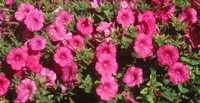
Bloom Time: Spring until Frost
Uses: Bedding, containers, or reseeding annual Note: Selected
and propagated in San Antonio, Texas. Commercial Seed Source is
Wildseed
Farms in Fredericksburg, Texas.
A Purple 'Laura Bush' seedling has been selected
by Larry Stein, Extension Horticulturist for the Texas Agricultural
Extension Service, to add a new color dimension to the already
- dynamic 'Laura Bush'. Purple 'Laura Bush' Petunia - Petunia
X violacea 'Laura Bush' Reseeding old fashioned petunia with fragrant
pink flowers on a vigorous heat tolerant plant.
Sun Exposure: Full Sun
Size: 24" Tall x 36" Wide
Bloom Time: Spring until Frost
Uses: Bedding, containers, or reseeding annual
Note: Selected and propagated in San Antonio, Texas. Commercial
Seed Source is Wildseed
Farms in Fredericksburg, Texas
GROWING 'LAURA BUSH' PETUNIAS:
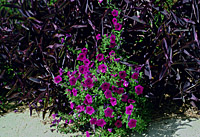 Petunias
should be planted in full sunlight, if possible, since even the
'Laura Bush' will become spindly and have fewer flowers if grown
in the shade. This is not to say that petunias will not tolerate
moderate or light shade, but they need a minimum of seven hours
of direct sun. The 'Laura Bush' petunia has a trailing habit which
can be enhanced by periodic trimming during the growing season.
I have mentioned that the 'V.I.P.' petunia is tough but I have
not indicated just how TEXAS TOUGH this petunia type really is.
Normally petunias planted any later than April in this area NEVER
have a chance to bloom before the extreme summer temperatures
annihilate plants. Petunias
should be planted in full sunlight, if possible, since even the
'Laura Bush' will become spindly and have fewer flowers if grown
in the shade. This is not to say that petunias will not tolerate
moderate or light shade, but they need a minimum of seven hours
of direct sun. The 'Laura Bush' petunia has a trailing habit which
can be enhanced by periodic trimming during the growing season.
I have mentioned that the 'V.I.P.' petunia is tough but I have
not indicated just how TEXAS TOUGH this petunia type really is.
Normally petunias planted any later than April in this area NEVER
have a chance to bloom before the extreme summer temperatures
annihilate plants.
It is generally not necessary to apply any
fertilizer before 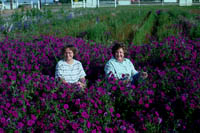 planting.
However, one week after the plants have been planted, begin applying
fertilizer. Use a slow release fertilizer with an analysis such
as 19-5-9 at the rate of 2-3 pounds per 100 square feet of bed
area. Be sure to water the fertilizer into the soil and remove
any that may have fallen on the foliage of the plants. Apply fertilizer
monthly throughout the growing season. Water soluble fertilizer
high in analysis such as 20-20-20 may also be used with the first
application being made the day the petunias are planted. Apply
the water soluble fertilizer as instructed on the container. planting.
However, one week after the plants have been planted, begin applying
fertilizer. Use a slow release fertilizer with an analysis such
as 19-5-9 at the rate of 2-3 pounds per 100 square feet of bed
area. Be sure to water the fertilizer into the soil and remove
any that may have fallen on the foliage of the plants. Apply fertilizer
monthly throughout the growing season. Water soluble fertilizer
high in analysis such as 20-20-20 may also be used with the first
application being made the day the petunias are planted. Apply
the water soluble fertilizer as instructed on the container.
'Laura Bush' petunias have another decided
advantage over many other plants in that they have relatively
no serious insect or disease pest. Aphids may become a problem,
but these can be controlled by spraying or dusting the plants
with Malathion or diazinon. Slugs also seem to like to feed on
petunias and these can be controlled by the use of baits. A good
preventive measure for fungus diseases is to avoid 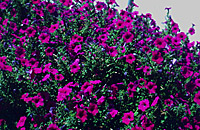 watering
plants from above and wetting the foliage. This can be accomplished
by the installation of drip irrigation tubing in the flower bed
before planting. If the plants become contaminated with a fungus
disease, pick off the infected leaves or flowers and spray remaining
leaves, weekly with a fungicide such as benomyl (Systemic Fungicide),
bayleton (FungAway) or Ortho Funginex. watering
plants from above and wetting the foliage. This can be accomplished
by the installation of drip irrigation tubing in the flower bed
before planting. If the plants become contaminated with a fungus
disease, pick off the infected leaves or flowers and spray remaining
leaves, weekly with a fungicide such as benomyl (Systemic Fungicide),
bayleton (FungAway) or Ortho Funginex.
It is also important to remember that petunias
don't like water on their flowers. Note that, after a rain, petunias
close up and appear to be wilted. So, when you water, use a watering
wand or drip irrigation system so plants are watered well at ground
level. Once water has touched the flower, it will take several
days before it is fully open again. This is especially true of
the Grandiflora bloom types.
Related Articles:
|



